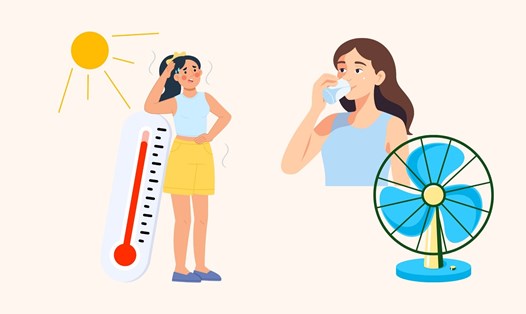A male patient from Bac Ninh has just been transferred to the Emergency Department, Central Hospital for Tropical Diseases in critical condition after a day of working outdoors in the hot weather.
The patient works as a construction worker and begins to feel tired around 15-16 hours after many hours of continuous work in the sun. The patient becomes absent-minded, uncommunicative, then appears unusual symptoms such as seizures, disturbances of consciousness and loss of control of behavior. When taken to a medical facility by his family, the patient was in a state of complete stiffness, bitten on the tongue, causing a bleeding mouth and a fever of up to 42 degrees Celsius.
On June 5, MSc. Dr. Truong Tu The Bao - the doctor directly treated - said that the patient was admitted to the hospital with typical signs of severe heat stroke, including: excessive body heat, central neuropathy disorders such as convulsions, drowsiness, coma; accompanied by electrolyte disorders and acute liver and kidney damage. In particular, the patient had a history of alcohol abuse and cirrhosis, which made him susceptible to heat and sugar, and made the condition worse and recovered more slowly than usual.
Tests show high liver enzymes, a clear sign of liver damage, most likely due to the simultaneous effects of alcohol and heatstroke, said Dr. Bao.
According to the patient's family, the patient had a habit of drinking alcohol regularly even though his health had recently declined. Overusing alcohol not only damages the liver but also reduces the body's ability to adapt to heat, making the body susceptible to collapse in extreme weather.
The patient is now out of danger, is being closely monitored at the hospital and actively treated with measures such as IV fluids, electrolyte regulation, supporting liver and kidney function. Biological indicators will be monitored to assess the possibility of recovery in the coming days.
According to Dr. Bao, heat stroke occurs when the body accumulates heat due to prolonged heat, causing natural heating mechanisms to no longer work effectively. There are two common mechanisms for causing heatstroke: One is direct sunlight on the head and neck, which can cause central neuropathy disorders, leading to drowsiness, fainting, and even death. Second, when the body is exposed to high environmental temperatures for a long time, the ability to excrete heat is limited, leading to electrolyte disorders, circulatory failure, and multiple organ damage such as liver, kidneys, and brain.
Initial symptoms of heat stroke include fatigue, dizziness, nausea, headache, rapid breathing, increased body heat, drowsiness and seizures. If not detected and treated promptly, the patient can quickly fall into a deep coma, acute liver failure, muscle necrosis, multiple organ failure and death.
Doctors recommend that outdoor workers need to be given reasonable rest time, especially avoiding working during hot hours from 10am to 4pm. When working, you should wear a wide-brimmed hat, wear long-sleeved clothes, use a collar protector, and drink enough water and supplement electrolytes regularly to avoid dehydration and physical disorders. When you experience unusual signs such as fatigue, dizziness or headaches, you should immediately stop work, find a cool place to rest and closely monitor your health.
For people with chronic diseases such as cirrhosis, kidney failure, or alcohol abuse, the risk of heat stroke and serious complications will be much higher. Therefore, it is necessary to be especially careful when working in hot weather conditions.
If you suspect that someone is suffering from heatstroke or heat stroke, you should quickly take the victim to a cool place, cool down the body by wiping the person with a warm towel, light fan, giving him water to drink if he is still alert and quickly transfer him to the nearest medical facility for timely treatment.











